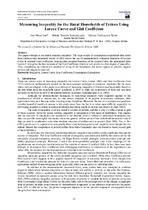| dc.contributor.author | Habte, Amine Teclay | |
| dc.contributor.author | Said, Said Mussa | |
| dc.contributor.author | Tekleghiorghis, Melake Tewolde | |
| dc.date.accessioned | 2021-03-18T11:52:08Z | |
| dc.date.available | 2021-03-18T11:52:08Z | |
| dc.date.issued | 2016 | |
| dc.identifier.citation | Habte, A. T. et al. (2016). Measuring inequality for the rural households of Eritrea using Lorenz curve and Gini coefficient. ,International Journal of African and Asian Studies, 17, 10-22 | en_US |
| dc.identifier.issn | 2409-6938 | |
| dc.identifier.uri | http://hdl.handle.net/10566/5991 | |
| dc.description.abstract | This paper attempts to accurately measure inequality. The large sample of consumption expenditure data taken
from Eritrean rural household survey of 2009 allows the use of parameterized continuous functions of Lorenz
Curve to estimate Gini Coefficient. Among other assumed functions of the Lorenz Curve, the generalized Beta
Lorenz Curve gives the best estimate of the Gini Coefficient which in turn results in a low degree of inequality.
Thus, considering the current low standard of living of the households, the results appear to partially support
poverty and inequality trade-off | en_US |
| dc.language.iso | en | en_US |
| dc.publisher | IISTE | en_US |
| dc.subject | Inequality | en_US |
| dc.subject | Lorenz curve | en_US |
| dc.subject | Gini coefficient | en_US |
| dc.subject | Consumption expenditure | en_US |
| dc.subject | Rural households of Eritrea | en_US |
| dc.title | Measuring inequality for the rural households of Eritrea using Lorenz curve and Gini coefficient | en_US |
| dc.type | Article | en_US |

